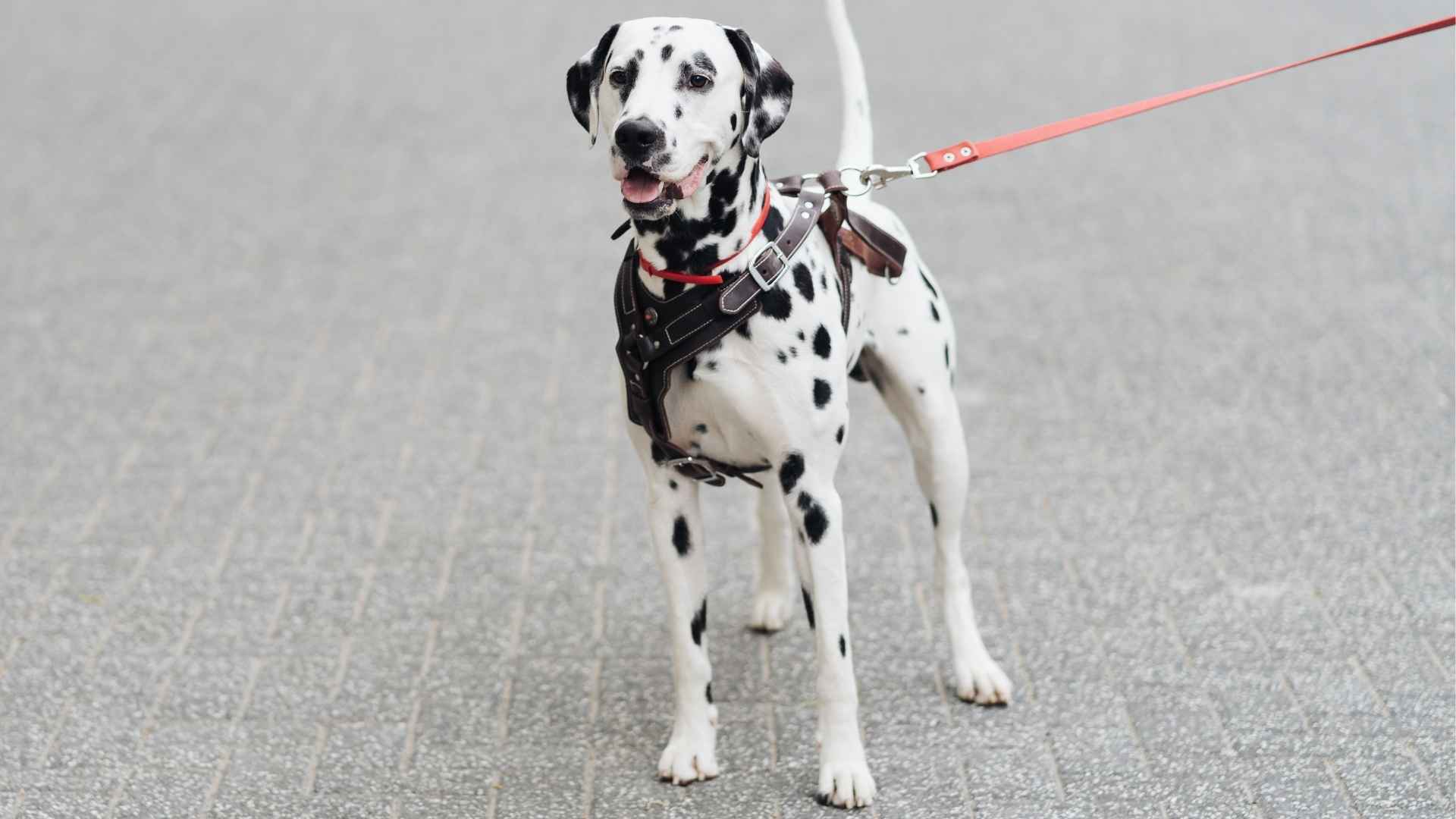The world of dog coats is a canvas of stunning variety—from sleek solids to mesmerizing markings—but few are as captivating as piebald patterns. These unique coats, defined by bold patches of unpigmented (white) fur interspersed with a base color, create a striking visual appeal that’s hard to miss.
Piebald patterns aren’t confined to one breed; they appear across diverse canine lineages, often hinting at the breed’s origins or purpose. Whether guarding flocks or chasing game, dogs with piebald coats carry both charm and legacy in their fur.
The piebald gene plays a fascinating role here, expressing itself in different ways, even within a single breed. The result? A wide range of coat designs, each with its own personality. In this blog, we explore the fascinating world of some piebald pattern dog breeds that are sure to catch your eye—and maybe your heart—by combining beauty, history, and genetic artistry in one irresistible package.
Understanding Piebald Genes and how it works?
The piebald gene produces a unique coat pattern marked by irregular, asymmetrical patches of unpigmented white fur where the dog’s natural coat color, typically black or brown, would normally appear. This genetic trait also affects the skin beneath the fur: pigmented under dark areas and unpigmented (pink) beneath white patches.
Dogs with standard piebald coats usually have a mostly white body with scattered patches of color on the head, body, or tail, and typically a black nose. In cases of extreme piebald, dogs may appear almost entirely white with only minimal color on the head or tail base, and may have partly pink noses.
Research suggests that while visually striking, extreme piebald expression can sometimes lead to health concerns, such as an increased risk of deafness, due to a lack of pigment in the inner ear, and a higher susceptibility to sunburn and skin cancer on exposed, unpigmented skin.
Dog Breeds With Unique Piebald Patterns
1. Dalmatian
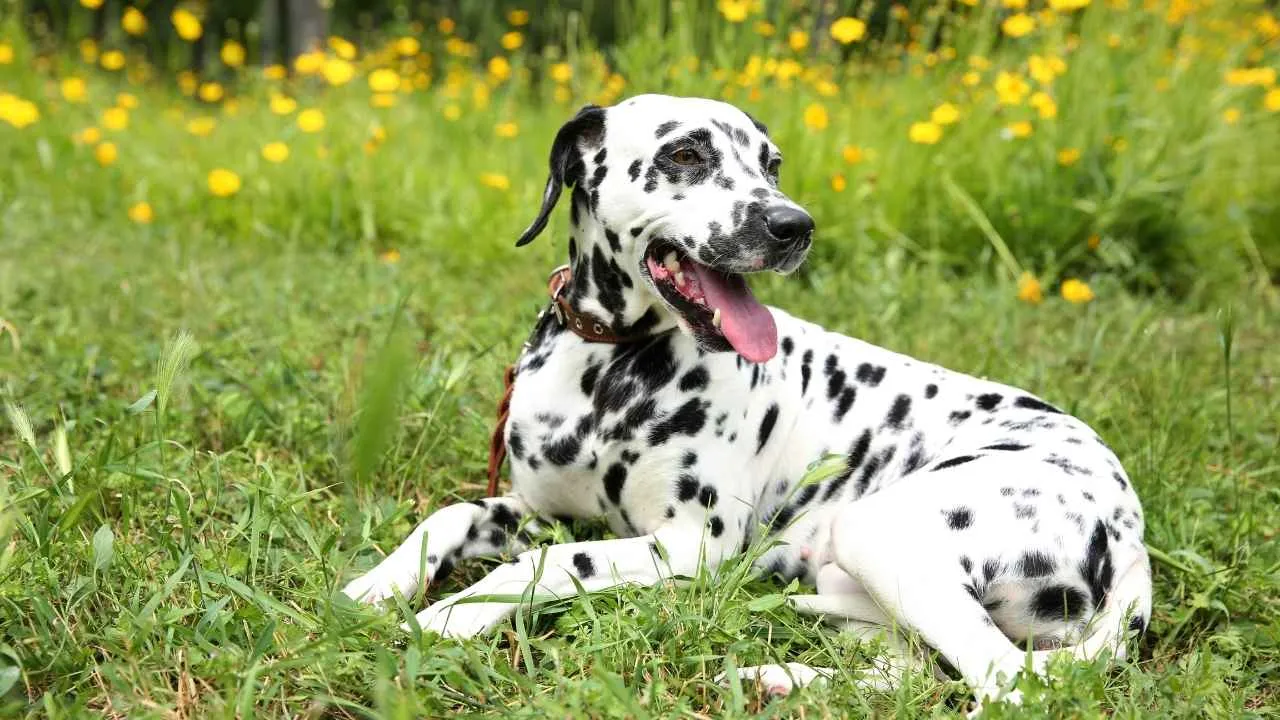
Dalmatians are more than just pretty pups with eye-catching coat patterns—they have a rich history, too. Known as the original fire dogs, they once ran alongside horse-drawn fire carriages in the 1700s, barking to clear the way. Today, they still play a role in fire stations, mostly as mascots and educators, bringing comfort to firefighters and helping teach kids about fire safety.
These dogs are bursting with energy and thrive in homes where they can stay active. Whether it’s agility training, long runs, or fun games in the backyard, Dalmatians love having a job. Their intelligence and independence make early training essential, as they like to take the lead if allowed.
While a predominantly white dog, that iconic coat is crisp white canvas with black or liver spots, all thanks to a combination of the piebald, ticking, and flecking genes.
No two Dalmatians have the same pattern, making each one a true original. This striking appearance is deeply tied to the breed’s identity and fame, but there’s more beneath the surface.
Did you know?
One important health issue in the breed is deafness, which is linked to the extreme piebald gene responsible for their coat and, sometimes, blue eyes. Around 15–30% of Dalmatians experience hearing loss, with about 5% deaf in both ears. That’s why hearing tests are a must—only dogs with normal hearing in both ears should be bred to reduce the risk in future generations, states UFAW.
2. Bull Terrier
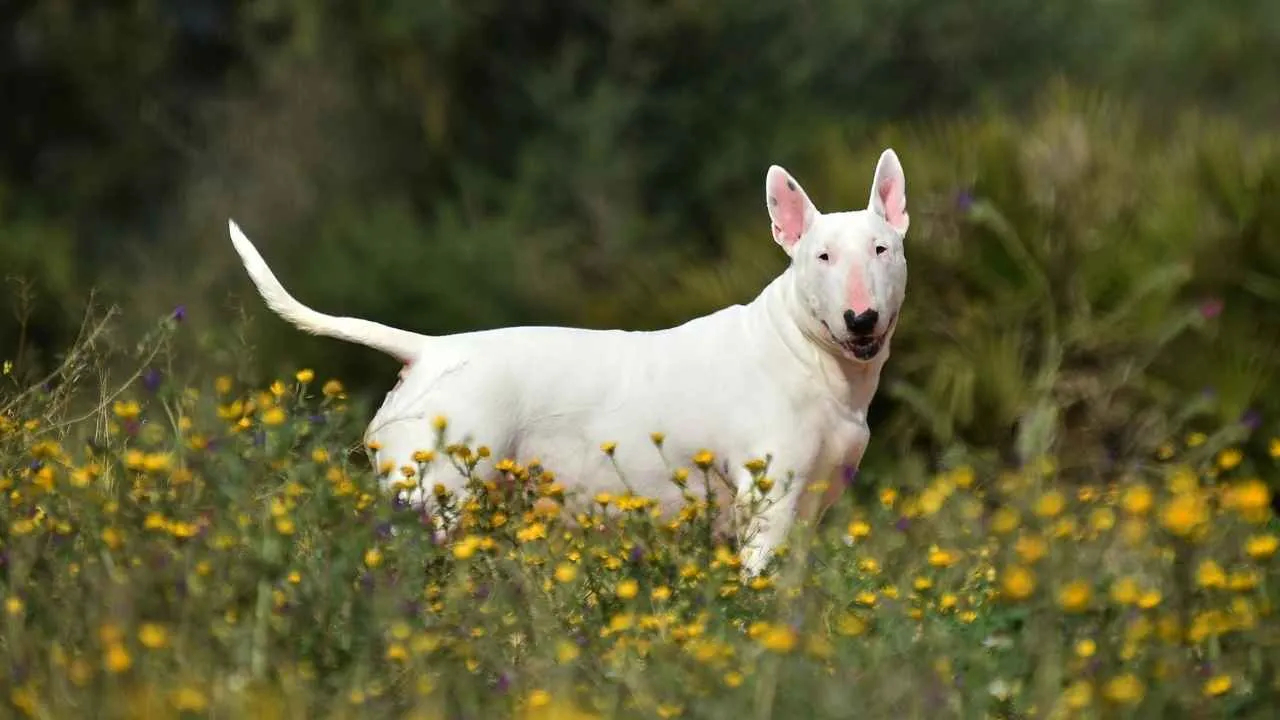
The Bull Terrier is a breed like no other, instantly recognizable by its unique egg-shaped head, sloped Roman nose, and trademark triangular eyes—the only breed with such a feature. Originally developed in 19th-century England by crossing Bulldogs with the now-extinct White English Terrier.
These were later mixed with breeds like the Dalmatian and possibly the Greyhound or Spanish Pointer, Bull Terriers were first bred for the fighting pits. Despite that tough beginning, today’s Bull Terriers have long since traded their past for a much more affectionate and fun-loving role in family life.
With their short, sleek coats and muscular build, Bull Terriers stand out not only for their physical strength but also for their striking looks. Many exhibit piebald patterns—mostly white coated dogs, with colored patches around the head or body—adding to their already eye-catching appearance. These markings vary from dog to dog, making each Bull Terrier delightfully unique.
In breeds like Boxers and Bull Terriers, dogs with two copies of the MITF gene variant are typically completely white, while those with one copy show the mantle or “flash” pattern. However, other genetic mutations may also influence the extent of white markings.
In many other breeds, piebald is a recessive trait, meaning two copies are needed to produce white spotting. Genetic testing for piebald helps breeders plan matings to achieve desired coat patterns.
Fun Fact:
Bull Terriers have even made their mark in pop culture. In the late ’80s, a Bull Terrier named Spuds MacKenzie became a beer commercial sensation, boosting Bud Light’s sales by 20%. Impressive!
3. American Pit Bull Terrier
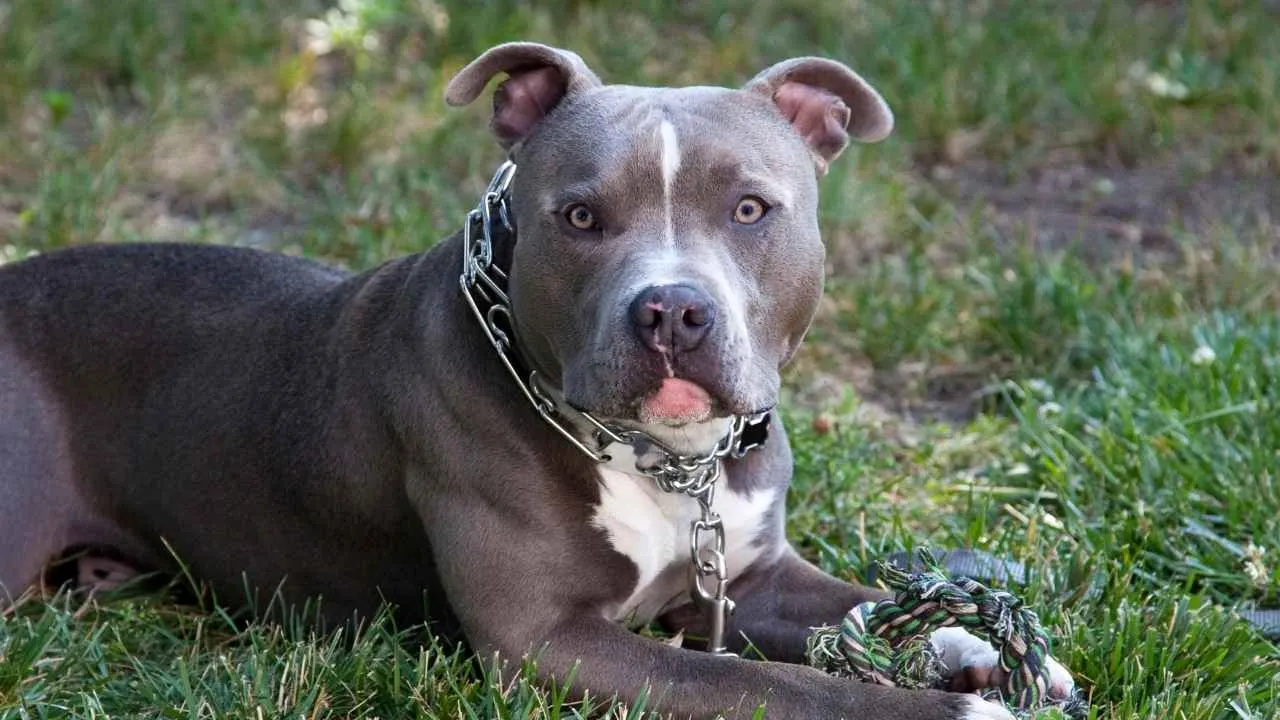
Pit Bulls, often referred to as American Pit Bull Terriers, have a history as complex as their personalities. Originally bred in England for bull baiting and later used in dog fighting after arriving in the U.S., their past has contributed to a controversial reputation.
However, today’s Pit Bulls are often affectionate, loyal, and deeply devoted to their families. They’re energetic and intelligent, which means they thrive best with owners who provide plenty of exercise and mental engagement.
Despite their strong-willed nature, many Pit Bulls form incredibly close bonds with their people, often earning the nickname “Velcro dogs” for their love of staying close. When properly trained and socialized, they can be wonderful companions for families, especially those with older kids.
Among their many coat variations, some Pit Bulls display striking piebald patterns—large, often asymmetrical white patches mixed with colors like black, red, blue, or fawn. These markings emphasize their muscular build and give each dog a distinct appearance.
The genetics behind these patterns are complex and not fully understood, with expression varying widely even within the same litter. But no matter the pattern, a well-loved Pit Bull shines brightest for their warm, loyal heart and playful spirit.
4. Beagle
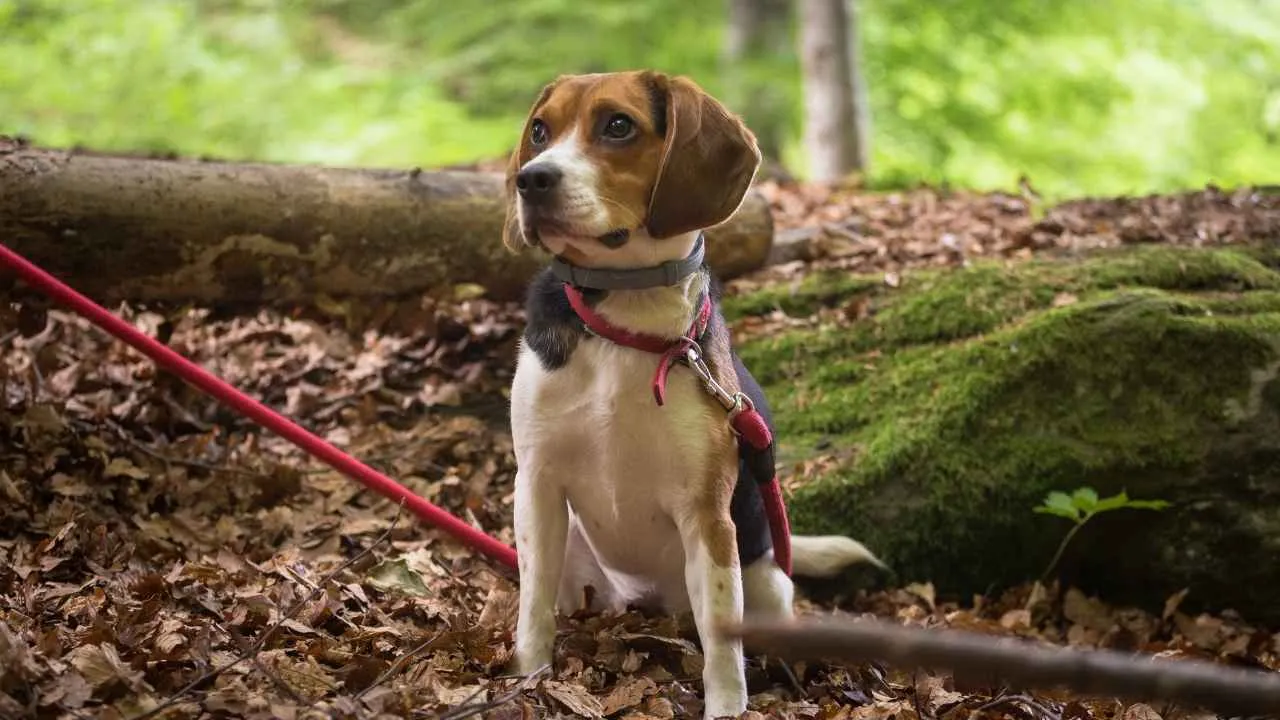
Beagles are one of the most beloved small hound breeds, known for their charming looks, friendly personality, and strong hunting instincts. With big brown eyes, floppy ears, and a sturdy build, they resemble mini foxhounds and typically sport a black, tan, and white coat.
Originally bred to hunt in packs, Beagles are sociable and rarely quarrel with other dogs, making them great companions in multi-pet households. They’re cheerful, curious, and always ready for an adventure, though their independent streak can make training a bit of a challenge, according to Britannica.
Though energetic outside, Beagles can be calm and cuddly indoors, provided they aren’t left alone for too long. They form strong bonds with their families and thrive on companionship. Without proper engagement or training, they may become noisy or even a little destructive.
But with love, patience, and plenty of playtime, a Beagle’s loyal and entertaining nature makes them a delightful addition to just about any home.
Among Beagle coat types, the classic tricolor is most common, but some exhibit the piebald pattern—large white patches that interrupt the standard coloring. This unique look comes from the piebald gene, which affects pigmentation by creating unpigmented areas on the coat.
The extent of white varies from dog to dog and often appears on the chest, legs, or tail. To express this pattern, a Beagle must inherit two copies of the recessive gene.
5. Fox Terrier

Fox Terriers are lively little dogs from England with big personalities packed into compact frames. Known for their mischievous charm and bold energy, they’ve long been favorites in traditional British fox hunts.
Originally bred to flush out foxes and chase down vermin, their predominantly white coats weren’t just stylish—they were functional, making it easier for hunters to spot them in the field.
Their coat can feature black, tan, or both as markings, often in unpredictable, asymmetrical patterns, thanks to the piebald gene and other color genetics.
These dogs are quick-witted and full of fun, making them delightful for pet parents who love a little sass in their sidekick. Though small—typically around 15 to 18 pounds—they’re athletic and spirited, never backing down from a challenge. Whether you’re chasing ribbons in a dog show or just playing fetch in the yard, a Fox Terrier is sure to keep life interesting.
These terriers come in two coat types—smooth and wire—but both share that distinctive alert expression, a sleek frame, and a reputation for being smart, spunky, and endlessly entertaining.
Smooth Fox Terriers, in particular, are known for their sleek appearance and energetic temperament, with compact bodies, flat V-shaped heads, and a lively step that sets them apart in the show ring.
6. Basset Hound
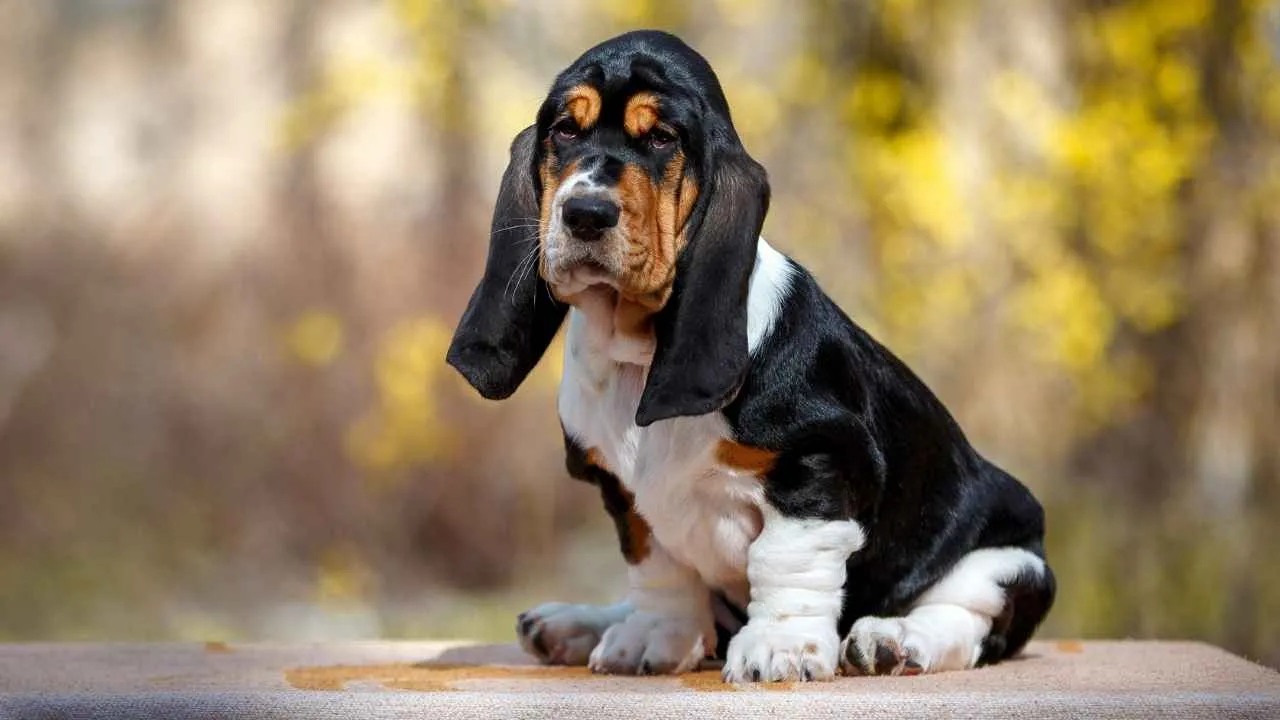
The Basset Hound may look like it’s perpetually frowning, but don’t be fooled by its solemn expression—this dog is a gentle, affectionate companion with a calm, quietly playful nature. Bassets thrive on companionship and don’t enjoy being left alone. Their easygoing temperament makes them great family dogs.
As noted American Kennel Club (AKC), what truly sets the Basset Hound apart is its nose, second only to the Bloodhound in scenting ability. And it’s not just the nose doing all the work. Those signature long ears sweep scents up from the ground, and their droopy facial skin helps trap smells close, giving them an extraordinary tracking edge. This natural super-sniffer makes them stars in scent work competitions, tracking challenges, and field trials.
When it comes to their appearance, Basset Hounds display a range of coat colors influenced by several genes, including those affecting black pigment and coat pattern. Most commonly, you’ll see tricolor combinations of black, white, and tan, or bicolor patterns like lemon and white.
True black and white Bassets are rare—there’s almost always a hint of brown or tan near the eyes. Some may even show a piebald pattern with distinct white spotting, adding to their already endearing charm.
7. Jack Russell Terrier
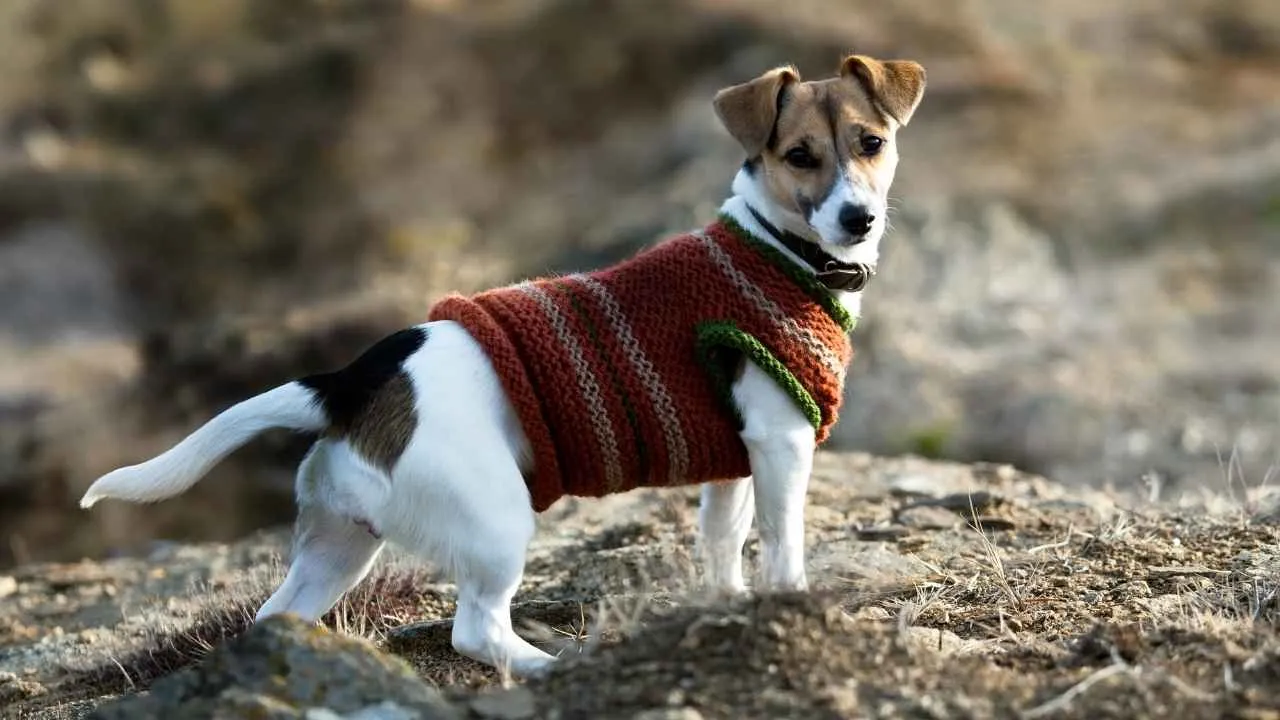
The Jack Russell Terrier, often mistaken as a single recognized breed, actually has two official pedigree types: the Jack Russell Terrier and the taller Parson Russell Terrier. However, the classic short-legged, sturdy little terrier that most people picture—feisty, compact, and full of personality—isn’t formally recognized as a breed by many kennel clubs.
These lively terriers typically stand between 10 to 14 inches tall, though some may be smaller. They come in a variety of coat types, including smooth, broken, or wire-coated, and are most commonly white with black or tan patches, or sometimes black with tan points.
Their distinct coloring is largely due to the piebald gene, which creates asymmetrical patterns of unpigmented white fur mixed with patches of the dog’s natural coat color. Underneath, the skin is pigmented beneath the darker areas and unpigmented under the white.
This gene is shared by several other breeds with similar coat styles, such as the Bull Terrier, Beagle, Dalmatian, and English Setter. In Jack Russells, the pattern adds to their already eye-catching, scrappy charm.
What really defines a Jack Russell, though, is their bold and cheeky personality. These terriers have no concept of their small size—ready to take on the world with a wagging tail and a fearless heart.
Affectionate dog, clever, and delightfully mischievous, they’re just as comfortable snatching a snack from your plate as they are chasing down a squirrel or diving into a hedgerow. They’re high-energy, fast-thinking companions with a love for fun and a strong sense of humor—true big dogs in little bodies.
Conclusion
In the canine world, piebald patterns offer a striking and genetically rich display of coat variation. Found across many breeds—from Border Collies and Dachshunds to Great Danes and Australian Shepherds—this pattern features large white areas interrupted by patches of color, shaped by complex genetic factors like the s locus, kit gene, and incomplete dominance.
Even within the same breed, these patterns can vary greatly, with some dogs displaying extreme white or unique combinations like a brindle pattern or the merle pattern. Whether it’s the white collar of a German Shepherd mix or the blue merle coat of an Australian Cattle Dog, piebald markings enhance each breed’s unique appearance and vibrant spirit.
While these patterns can occasionally come with health considerations, such as deafness linked to pigment loss, they remain a visual hallmark of many beloved breeds. For active families and dog lovers drawn to distinctive looks and personalities, piebald-coated dogs are as fascinating as they are beautiful.


